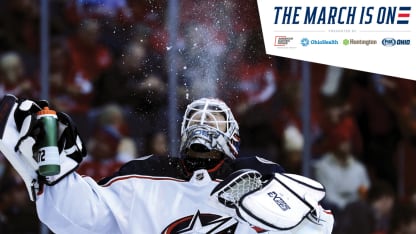As the season unfolded, people in the Columbus area crossed their fingers and hoped for two things: a second straight appearance for the Blue Jackets in the Stanley Cup Playoffs and anybody but the Pittsburgh Penguins in the first round.
Well, they got their wish.
The Penguins are locked into a bitter rivalry with the Philadelphia Flyers, while the Jackets get the Washington Capitals, otherwise known as the team that won the Metropolitan Division with 105 points.
Washington took the season series from Columbus with a 3-1-0 record in the four games, winning the first three, but this was a much closer series than the record indicates. The Jackets outshot the Capitals in all four games, lost one with 42.9 seconds left in the third period and proved by winning the final game, 5-1, they aren't intimidated.
This has the makings of an exciting, closely-contested series and the Blue Jackets know they can win. In order to do that, and advance past the first round of the playoffs for the first time, here are five keys to follow:
Series Preview: Five keys for the Blue Jackets to eliminate the Capitals
Columbus can advance for the first time by winning or improving in these areas.

VISIT THE BLUE JACKETS STANLEY CUP PLAYOFF HUB
I: BAR DOWN
How important is scoring goals to winning?
Statistically splitting the Blue Jackets' season provides that answer, which seems obvious.
In their first 54 games, which included a 4-2 loss to the Capitals on Feb. 9 at Capital One Arena, the Jackets had scored 135 goals for an average of 2.50 per game. That total ranked 29th in the NHL, dragged down in part by a power play clicking at just 13.8 percent (31st).
The Jackets' record of 27-23-4 was above .500, but only because they'd allowed just 150 goals, which ranked 10th. That works out to a goal differential of minus-15, which isn't going to win many games or get you into the playoffs.
Columbus had 58 points after that loss to the Capitals and sat two spots out of the second wild card in the Eastern Conference, behind the Carolina Hurricanes and New York Islanders. Everything changed the next day, Feb. 10, when the Blue Jackets blitzed the New Jersey Devils 6-1 at Nationwide Arena, a bloodletting of sorts for a team that had outshot its previous four opponents - including the previous three by wide margins - and lost a season-high four straight games.
Starting with that game, Columbus then led the NHL in scoring in its final 28 games with 101 goals for an average of 3.61 per game, or 1.11 more per game than the first 54 games. Their goal-differential during that span was plus-25, allowing just 76 goals, and their power play increased to 24 percent, which ranked seventh.
If the Blue Jackets are going to win this series, they need to keep filling the net with pucks like they did the past two months.
"Guys are feeling good about themselves and their game, and that has to continue," captain Nick Foligno said. "It has to carry over to the games. We definitely feel there's a confidence in that offensive ability that maybe we didn't have at the start of the year. It's helped us win hockey games and needs to help us win hockey games moving forward."
II: IN 'BOB' THEY MUST TRUST
There was a moment during practice Tuesday at Nationwide Arena that had to make the Blue Jackets chuckle.
Sergei Bobrovsky, their rock in net, decided to grab a few splashes of water from the bottle on top of the net. Only, he didn't wait until a break in the action. He just cranked up his mask, laid his stick on the net, grabbed the bottle and gave it a squirt - turning just in time to see a shot coming off a line rush.
The puck was headed low to the left side of the net and Bobrovsky casually stuck out his right pad out to turn it away. He gave the bottle another squeeze, turned to the bench - where team staffers looked on - and gave them a big smile with an extended wave of his left hand.
Then, he flipped his mask down and got back to work. So, if 'Bob' is nervous or concerned about being back in the playoffs, where he's struggled in the past, he's hiding it well.
"That's a great sign of a goalie, that he's locked in and laser focused when he needs to be, but he's also enjoying this and having fun with it," Foligno said. "That's what you need. You need a relaxed focus and 'Bob' has that right now. I'm excited to see what he's going to do [starting] Game 1."
Foligno's not the only one. Many eyes will be on Bobrovsky, to see if he can play up to his own elite standards from the regular season.
Bobrovsky's splits between the regular season and playoffs are night and day different. He's 218-129-36 with a 2.44 goals-against average and .920 save percentage in 395 career NHL regular-season games (285 starts) but just 3-10 with a 3.63 GAA and .887 save percentage in 18 Stanley Cup Playoff games (14 starts).
Last season, when he won the Vezina a second time for a stellar year, his numbers were 3.88 GAA and .882 save percentage in the Jackets' five-game series loss to the eventual-champion Pittsburgh Penguins.
Regardless, the Blue Jackets know what kind of talent Bobrovsky has in net.
"This is an opportunity," Foligno said. "You've seen a more mature 'Bob,' a guy who understands himself more, and he's a guy that's going to rise to that occasion, because he has every time he's been challenged. We have full confidence in his abilities. If I had to pick anybody in the league to go to the playoffs with, it would be him. And I think he's pretty confident about the team in front of him as well."
III: SAFE IS STILL DEATH
Pushing the pace with active defensemen, who aren't afraid to join the rush or pinch low in the offensive zone, can't just be a thing for the regular season.
If anything, the Blue Jackets' blue-liners may need to take even more risks in the playoffs, when it becomes even tougher to score goals. It's a risk-reward deal, just like always, but the payoff could be even more significant.
It's a lot more difficult to defend Columbus when the goals are coming from all over the ice, including the top pairing of Seth Jones and Zach Werenski. Each scored 16 goals this season, which meant they now share the franchise record for most goals by a defenseman in one season. They're one of just four sets of teammates ranked among the top 20 in goal-scoring by defensemen, and their 32 combined goals are the most among them.
Columbus will need its secondary defensive scoring, as well, including second-year defenseman Markus Nutivaara - who's returning from an upper-body injury. Nutivaara scored an NHL career-high seven goals in 61 games this season.
IV: POISE, BOYS
Tom Wilson had a nice season for the Capitals, with 14 goals, 13 assists and 27 points.
He also spent 187 minutes in the penalty box. That's 119 minutes more than Washington's second-most penalized player, defenseman Brooks Orpik - who was boxed for 68 minutes. That's also 137 more penalty minutes than Foligno served as the most penalized Blue Jacket.
So, it's no secret what Wilson - and to a lesser extent Orpik - are on the ice to do. They contribute in other ways, but they're also the Capital's top cops, who will be flying around the ice looking to inflict as much pain as they can, and maybe draw some retaliatory penalties.
Considering how good the Capitals' power play is, and how inconsistent the Jackets' penalty-killing has been this season, Columbus can't fall into that trap.
"We've been a pretty disciplined team most of this year," coach John Tortorella said. "We can handle that. The key thing is you just can't get amped up to where you retaliate. Those are the penalties you don't kill off. If someone's standing in our blue [paint] and he's on [Bobrovsky], I don't care what you do there. If we take a penalty, we take a penalty, because you usually kill those off. It's the sloppy ones, the offensive-zone penalties, the retaliatory penalties … those are the ones that end up in the back of your net."
V: PATCH THE P.K.
Speaking of killing penalties, that's a good segue into the fifth key to the Blue Jackets winning this series.
They have to push the reset button, again, and fix the penalty-kill effort. It's been a turbulent, up and down season for the Jackets' PK units, which started strong - especially at home - dropped off a cliff for about a month, improved again and then slumped in the final few games of the regular season.
"It's been inconsistent this year," Tortorella said. "I'm not going to hide from that. You get into playoffs, just try to wipe the slate clean and get about your business here. We can focus in on their tendencies. That's a big part of the series. Hopefully, we're smart enough that we keep control of ourselves, our emotions, we're a disciplined team and not sitting in that box a whole bunch in this series."
Columbus allowed 10 power-play goals in its final 10 games, successfully killing just 67.7 percent of 31 shorthanded situations (21-of-31). The Blue Jackets allowed at least one power-play goal in the last three games, going just 5-for-11 and 45.5 percent to end the season.
To be fair, they rested a number of top players Saturday, in a 4-2 loss to the Nashville Predators to conclude the season. The Jackets allowed two power-play goals in that game, going 3-for-5 killing penalties.
Still, it's been an issue lately and has bitten Columbus in all four games against the Capitals. That's one reason the red practice jerseys came out Monday and the Blue Jackets worked on defending Washington's power play - which finished the season ranked seventh overall at 22.5 percent.
"In any playoff series, special teams are very important," Tortorella said. "Washington, their power play is a very important part of their offense. Sure, that's going to be a huge point in this series, how we [defend] it. I don't think we're going to stop it completely. We have to do a better job with our killing than of late."
















